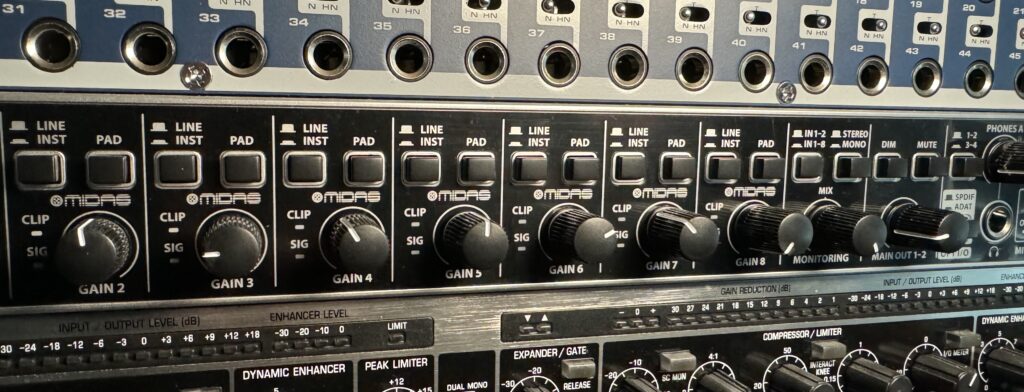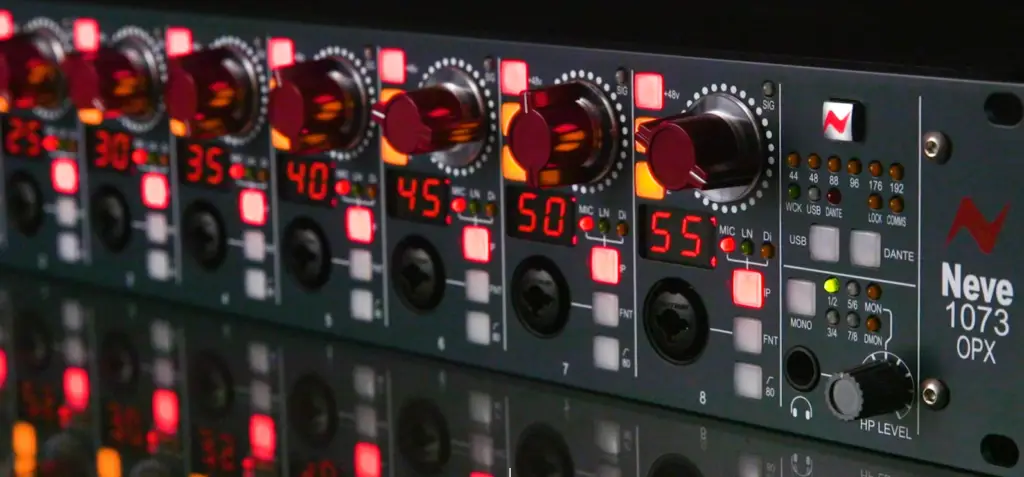***This post contains affiliate links. This means if you make any purchases using the hyperlinks below I may earn a commission, at no cost to you. Thank you for your support!
When it comes to capturing high-quality sound in music production, the preamp is one of the most crucial tools you can use. But what exactly is a preamp, and how does it work in music? If you’ve ever wondered what role this piece of gear plays in your setup, you’re not alone. In this article, we’ll dive into what a preamp does, how it works, and why you need it for recording music.
Preamp explained
A preamp, or pre, is short for preamplifier, is an essential part of any audio recording setup. Its primary role is to amplify weak signals, especially from instruments like guitars, microphones, and synthesizers, to a level that can be processed by other equipment. Without a preamp, the sound from your microphone or instrument would be too quiet, lacking the clarity and volume needed for recording or live performance.
How Does a Preamp Work?
A preamp works by boosting the audio signal to what’s known as “line level.” Line level is the standard signal strength that most audio equipment is designed to handle. This ensures that your sound has enough volume and quality before it reaches the mixing board, audio interface, or speakers.
When sound is initially captured by a microphone or an instrument, it’s in a very low-voltage form, often referred to as “mic level” or “instrument level.” This signal is not powerful enough to drive studio monitors or headphones by itself, and it would be nearly inaudible if played back. The preamp boosts this low-level signal to a higher voltage, bringing it up to the line level. Some interfaces, like the Behringer UMC1820 for example, have a switch to toggle between the mic and instrument level. This is incredibly handy as these signals need to be treated differently.
This boost makes a huge difference in the clarity and richness of your sound. A good preamp not only amplifies the signal but also adds warmth and character to the tone, especially if it’s a tube preamp. This is a reason why some engineers have favorite pre’s they like to use in their mixes
Different Types of Preamps
Preamps come in two primary types: solid-state and tube. Each type has its own strengths and is suited to different styles of music and preferences.
Solid-State Preamps
Solid-state preamps are known for their reliability and clean sound. They use transistors to amplify the signal and are generally more affordable and durable than tube preamps. If you want a transparent sound that doesn’t color your audio too much, a solid-state preamp is a great option. They are also less prone to overheating and are often used in home studios or live setups where durability is key. Again, if you have an audio interface already, it more than likely has solid state pre’s. This isnt a bad thing! Below you can see my Behringer UMC1820. It’s great for a number of reasons. One of them being the solid state Midas preamps. Very clear and crisp. Full review to come 😉

Tube Preamps
Tube preamps are a favorite among musicians and audio engineers for their warm, rich sound. They use vacuum tubes to amplify the signal, which adds a certain harmonic distortion that many find pleasing to the ear. This characteristic warmth is especially popular in genres like rock, jazz, and blues. However, tube preamps require more maintenance and are typically more expensive than their solid-state counterparts.
Both types of preamps can be used effectively in music production, but the choice depends on your personal preference and the kind of sound you’re aiming for and of course, budget. Speaking of budget, the ART tube MP Is a great budget tube pre. I personally like using it with my Bass DI to help warm up the sound and to bring it up in levels. And of course, link to the article here
Why Do You Need a Preamp?
Now that you understand what a preamp is and how it works, let’s talk about why you need one. The answer is simple: a preamp is essential for ensuring that your audio signal is strong enough to be recorded or amplified without losing quality. If you’re serious about recording music, whether in a professional studio or a home setup, you need a preamp to capture clear, detailed audio.
The preamp also plays a crucial role in shaping the tone of your recordings. As mentioned earlier, tube preamps can add warmth, while solid-state preamps provide a clean, transparent sound. This tonal shaping can make a big difference, especially when recording vocals, acoustic instruments, or even electric guitars.
How to Choose the Right Preamp
Choosing the right preamp depends on your needs, the type of music you make, and the gear you already own. If you’re looking for something affordable and reliable, a solid-state preamp is a great choice. They’re easy to use, durable, and won’t break the bank. You also, already have these if you have an audio interface!
On the other hand, if you’re after that classic, warm sound that can add depth to your recordings, a tube preamp might be worth the investment. Just keep in mind that tube preamps require more care, and you might need to replace the tubes from time to time.
Using a Preamp with Other Gear
A preamp is often used alongside other important pieces of audio gear, like compressors and equalizers. In fact, one of the best ways to enhance the sound of your recordings is by running your signal through a preamp, followed by a compressor. If you’ve read our article about compressors, you’ll remember that they help control the dynamics of your audio by reducing the volume of the loudest parts and boosting the quieter sections.
When paired with a preamp, the combination of boosted signal and controlled dynamics can take your sound to the next level, giving you a professional quality that stands out in any mix. It’s especially useful for vocals, where maintaining a consistent volume is crucial.
Conclusion
To recap, a preamp works by amplifying weak signals from instruments and microphones, bringing them up to a level that can be processed by other audio equipment. Choosing between a solid-state or tube preamp depends on your sound preferences and setup. And when paired with other gear like compressors, a preamp can help create polished, professional recordings.
So, whether you’re just starting out or are an experienced musician, understanding how a preamp works will give you greater control over your sound, helping you to elevate your sound.

